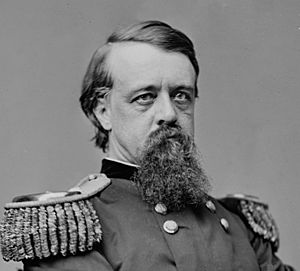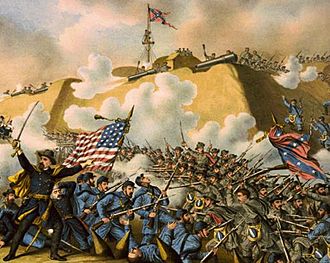Alfred Terry facts for kids
Quick facts for kids
Alfred Howe Terry
|
|
|---|---|
 |
|
| Born | November 10, 1827 Hartford, Connecticut, U.S. |
| Died | December 16, 1890 (aged 63) New Haven, Connecticut, U.S. |
| Place of burial |
Grove Street Cemetery, New Haven, Connecticut, U.S.
|
| Allegiance | United States Union |
| Service/ |
United States Army Union Army |
| Years of service | 1861–1888 |
| Rank | |
| Commands held | 2nd Connecticut Volunteer Infantry X Corps Military Division of the Missouri |
| Battles/wars | |
| Awards | Thanks of Congress |
| Other work | author |
Alfred Howe Terry (born November 10, 1827 – died December 16, 1890) was an important Union general during the American Civil War. He also served as a military leader in the Dakota Territory for many years. One of his biggest victories was leading Union soldiers to capture Fort Fisher in North Carolina in 1865.
Contents
Early Life and Start of His Career
Alfred Terry was born in Hartford, Connecticut. But his family soon moved to New Haven, where he grew up. He went to the Hopkins School and later studied at Yale Law School. After finishing his studies, Terry became a lawyer. He worked as a clerk for the Superior Court in New Haven County.
Alfred Terry in the Civil War
When the Civil War began, Alfred Terry quickly joined the Union side. He showed great leadership skills even though he hadn't been to a military school.
Fighting in South Carolina
Terry helped create the 2nd Connecticut Infantry Regiment. He was made a colonel of this group. His regiment fought in the First Battle of Bull Run. After this battle, Terry and his soldiers moved to South Carolina.
In 1862, he became a brigadier general. He was in charge of troops during the attacks on Charleston and Morris Island, South Carolina. His soldiers helped capture Fort Wagner in September 1863.
Battles in Virginia
Later, Terry's troops moved north to Virginia. They fought in battles around Richmond. These included the Battle of Proctor's Creek and battles during the Siege of Petersburg. Terry's leadership was strong, even if he didn't always get as much fame as other generals.
Victory at Fort Fisher

Terry's most famous moment in the war came when he led an attack on Fort Fisher. This fort was very important for the Confederates in North Carolina. Another general had tried and failed to capture it.
General Ulysses S. Grant trusted Terry to lead a second attack. Terry worked well with the Navy, led by David Dixon Porter. On January 13, 1865, Terry's soldiers attacked the fort. After tough hand-to-hand fighting, the Union troops took control.
For this big victory, Terry was promoted to major general. He is remembered as one of the most skilled generals who didn't have formal military training before the war. His troops then helped capture Wilmington, North Carolina.
After the Civil War
After the war ended, Alfred Terry continued to serve in the military. He played an important role in shaping the American West.
Working with Native American Tribes
Terry helped negotiate the Treaty of Fort Laramie (1868). This treaty aimed to end conflicts with Native American tribes like the Lakota Sioux. He also commanded troops during the Great Sioux War of 1876. His soldiers arrived after the famous Battle of the Little Bighorn, where George Armstrong Custer and his men were defeated.
Terry also helped during the Nez Perce War. He sent soldiers to help stop Chief Joseph and his people.
Other Important Roles
Terry was also a strong opponent of groups like the Ku Klux Klan. He served as a military governor in Atlanta, working to bring order and fairness after the war.
In 1878, he was part of a special board. They looked again at the case of General Fitz John Porter, who had been wrongly accused of cowardice. The board found that Porter was innocent.
In 1881, a new town in Montana was named Terry, Montana in his honor. This happened as the Northern Pacific Railway was building its tracks across the country.
Terry became a full major general in 1886. He was put in charge of a large military division in Chicago. He retired from the Army in 1888. He passed away two years later in New Haven, Connecticut, where he is buried.
Media Portrayals
Alfred Terry has been shown in several movies and TV shows:
- In 1967, Robert F. Simon played him in the TV series Custer.
- In 1974, Philippe Noiret played him in the movie Don't Touch the White Woman!.
- In 1991, Terry O'Quinn played him in the TV film Son of the Morning Star.
Images for kids
-
Terry as he appears at the Cape Fear Museum in Wilmington, North Carolina, near which he captured Fort Fisher in 1865.
See also
- List of American Civil War generals (Union)
- 7th Regiment Connecticut Volunteer Infantry
- Fort Terry



